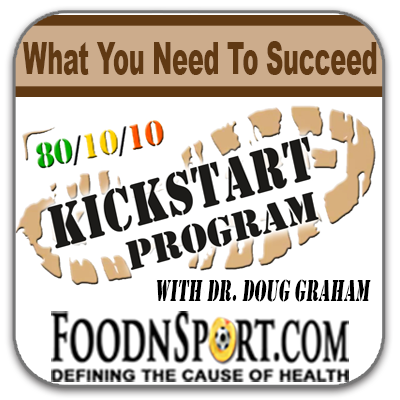Reversing Type 2 Diabetes in Less Than 6 Months - Case Study : The amazing mental, physical and emotional transformation that can occur with a strategic approach to plant-focused high-carbohydrate nutrition.
by Cyrus Khambatta, Ph.D.
Published: Wed, 05 Aug 13:0

There are literally thousands of people with stories like Cynthia's, which is detailed below by Dr. Cyrus Khambatta, Ph.D. Each of these Type 1 and Type 2 Diabetics have followed the same program, through the teachings and consultations with Dr. Graham or Dr. Khambatta, or at FoodnSport Retreats.
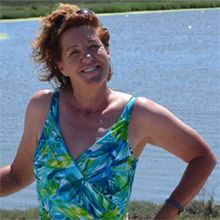
You can experience it yourself in September at the Conqering Diabetes Retreat in Washington State with Dr. Graham, Dr. Khambatta, Robby Barbaro and the FoodnSport Staff. Find out more here, and read Cynthia's full story below.
I'd like to take a moment to recognize the incredible 6-month transformation of Cynthia Bronte, who worked so diligently at reversing insulin resistance. This is another story that reflects the amazing mental, physical and emotional transformation that can occur with a strategic approach to plant-focused high-carbohydrate nutrition.
Diagnosis with Type 2 Diabetes
Cynthia was diagnosed with Type 2 Diabetes in 2003, in the midst of diabetic ketoacidosis (DKA), an acute life-threatening condition that typically marks the onset of type 1 diabetes. Cynthia's symptoms of DKA were unmistakable, and included urinating more than 14 times per day, insatiable thirst and low energy. Cynthia was unaware that her fasting blood sugar was 5 times higher than normal, at 550 mg/dL (normal blood sugars range from 70 - 130 mg/dL).
Treatment Protocol
When Cynthia was first diagnosed with type 2 diabetes, she was instructed to consume a low carbohydrate diet in order to minimize blood sugar. She was instructed to eat foods that were high in protein and fat, while limiting her intake of fruits, artificial sweeteners, grains, pastas, rice, bread and cereal. She was initially instructed to minimize her intake of carbohydrates to minimize the amount of glucose that would eventually appear in her blood.
Her diet plan followed what I refer to as "the linear diabetes nutrition model", shown below.
The problem with the linear model is that it does not address the underlying root cause of type 2 diabetes – insulin resistance. By eating a low carbohydrate diet, Cynthia was eating mainly fat and protein, resulting in increased lipid deposits in her liver and muscle tissue. In turn, increased fat storage in her liver and muscle resulted in severe insulin resistance and highly variable blood sugar values.
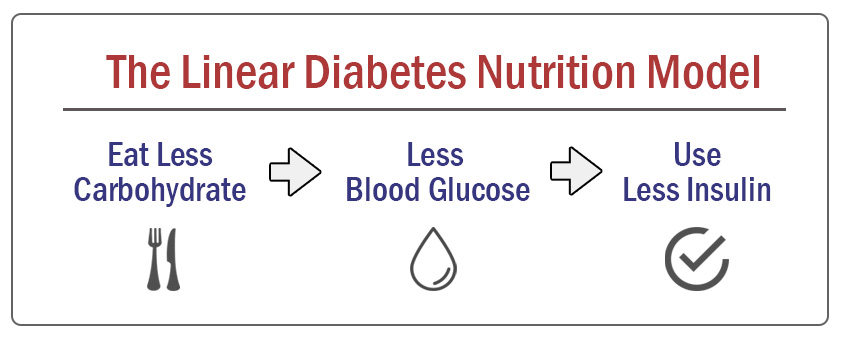
11 Years of Pain and Frustration with Type 2 Diabetes
Between the years of 2003 and 2014, Cynthia tried everything in her power to live a normal life. She has always been determined to live an active and energetic lifestyle, however living with type 2 diabetes quickly took its toll on Cynthia's mental, emotional, metabolic and physical health.
She recalls the past 11 years as a "battle" against her three most significant health challenges, including neuropathy, 5 life-threatening hypoglycemic events, severe eye pain, brain fog, memory loss and high blood pressure.
Symptom #1: Neuropathy
In a recent interview with Cynthia, she recounted the familiar feeling of high blood sugar. She reported the following:
"When my blood sugar increased beyond 160 mg/dL, I would experience joint pain throughout my body that felt like little pieces of glass tearing my body apart. That feeling would often last for 2-3 days and it was excruciatingly painful."
This feeling of nerve tingling is a classic symptom of diabetic neuropathy, a family of nerve disorders caused by chronically elevated blood sugars that manifest as pain, tingling, numbness and loss of feeling in the hands, arms feet and legs. Neuropathy can also affect joints, resulting in pain, instability and swelling.
In addition to joint pain, she recounted that high blood sugars also caused a burning sensation on her skin, affecting mainly her face and chest.
Symptom #2: Weight Gain
When Cynthia was first diagnosed with type 2 diabetes in 2003, she weighed 175 pounds. Over the course of 11 years her weight fluctuated significantly, peaking at 240 pounds in the middle of 2005. In the early part of 2014 just before starting the Mangoman Nutrition and Fitness Program, she weighed 215 pounds and was still considered more than 50 pounds overweight.
For many years she had attempted to lose weight unsuccessfully, and at 215 pounds she could feel the strain that extra weight was placing on her bones, joints, skin, digestive system and brain. Despite 11 years of hard work, Cynthia simply had no idea how to lose weight safely, effectively and most importantly FOREVER.
Symptom #3: Low Energy
One of the most classic symptoms of living with diabetes is a near complete loss of energy. Many people feel that living with diabetes is a constant battle for increased vitality and energy, and no matter what food they eat, the energy never seems to come.
Cynthia recalls feeling very lethargic in the morning, having to sleep until at least 8AM or 9AM just to get out of bed. In the same way that thyroid hormone deficiency can cause a strong feeling of lethargy, living with type 2 diabetes drained Cynthia of energy, irrespective of the amount of sleep she got.
In addition, when she did manage to fall asleep, she remembers having difficulty staying asleep, constantly bothered by a symphony of neurological flares from inflamed nerves all throughout her body.
Symptom #4: Life-Threatening Hypoglycemia
Cynthia was no stranger to hypoglycemia. She had experienced 5 life-threatening episodes, and recalls her experiences here:
"At first, I felt weak and nauseous, and my legs felt very heavy. Next, I would vomit, then go semi-unconscious and begin to convulse. I could hear things, but everything was black. Fortunately I was able to get out the words 'Diabetic, Juice.' Fortunately I had people around me every time that gave me juice to revive me. These episodes were scary. Truly scary."
Symptom #5: Eye Pain
By March, 2014 Cynthia's eyes had become extremely sensitive to light. She wore sunglasses all the time, and put filters on her computer screen to dim the incoming light. Sometimes people joked that she looked like a drug dealer, wearing sunglasses both indoors and at night.
Symptom #6: Brain Fog and Memory Loss
Cynthia noticed that when her blood sugar rose over 160 mg/dL, she would experience short-term memory loss. In addition, she found it very difficult to think clearly and stay focused.
Symptom #7: Hypertension
In February 2014, Cynthia’s blood pressure was 145/105, and was subsequently diagnosed with hypertension.
Making the Decision to Change From the Ground Up
In February of 2014, Cynthia attended one of my free webinars entitled, "Learn the Fundamentals of Blood Sugar Control Before, During and After Exercise." She listened with an open mind and was intrigued by the information that I provided on the seemingly counter-intuitive approach to reversing insulin resistance through high-carbohydrate nutrition. She wanted to understand more, but was intrigued by the approach and intuitively knew that this was the right approach for her.
Immediately, Cynthia applied the methods that I described in painstaking detail, including:
- Drastically reducing fat intake to less than 15% of total calories
- Significantly increasing carbohydrate intake from plant sources
- Increasing activity levels in a slow and sustainable manner
Results
Cynthia's body responded to this new approach immediately. Many markers of her overall health started improving right away, and her ability to control blood sugar improved as a result.
Learn This Life-Saving System At The Conquering Diabetes Retreat with Cyrus Khambatta, Ph.D., Dr. Douglas Graham and Robby Barbaro.
Result #1: Weight Loss
In March of 2014 Cynthia weighed 215 pounds. Today Cynthia weighs 165 pounds, and has lost more than 20% of her initial body weight. She looks incredible and feels better than she has ever felt.
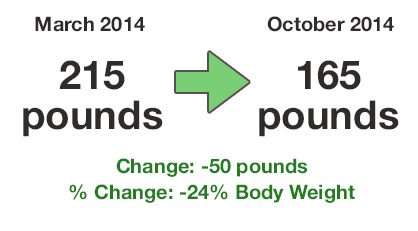
Result #2: Decreased Fasting Blood Sugars
Following the Mangoman Nutrition and Fitness plant-focused approach, Cynthia's blood sugars improved consistently throughout the 6 month period. When we first started working together, her fasting blood sugars averaged 176 mg/dL, and within 2 weeks her fasting blood sugar had fallen to 159 mg/dL. Over the course of the next month, her fasting blood sugar values came down predictably and reliably. After 6 months of the program her fasting blood sugar now averages 131 mg/dL.
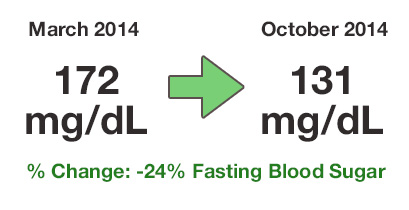
Result #3: Significantly Reduced Metformin Dependence
In 2008, Cynthia was taking 1000 mg/day of Metformin. In consultation with her doctor, Cynthia was able to back off on her dose of Metformin from 1000 mg/day to 500 mg/day. Within a few weeks of eating a low-fat high-carb diet, she began backing off on her daily dose in order to prevent low blood sugars.
Cynthia now uses 50% of her Metformin dose, and is working hard to become Metformin-free within the next few months.
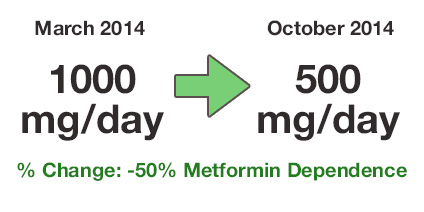
Result #4: No More Insulin
"Backed by rigorous science, this program (Dr. Graham's Conquering Diabetes) has helped countless people with type 1 diabetes take full control of their diabetes health."- Dr. Cyrus Khambatta, Ph. D.Cynthia started using insulin in 2008, in order to reduce her blood sugars beyond that which Metformin could do. Starting in 2008 she used 28 units of Novolin N every day, then added 15 units per day of Novolin R in September of 2013. Despite this, her blood sugars consistently ran high.
"Cynthia is now insulin free. In consultation with her doctor, Cynthia stopped injecting insulin altogether in July of 2014. She plans on remaining insulin free using diet and exercise as her "weapons" of choice."
"Getting off insulin was an amazing and liberating experience. It is the first time in eleven years of taking drugs, that I actually feel like I am living in a normal body again."
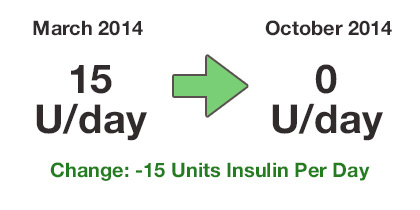
Result #5: Reduced A1c Values
When Cynthia was first diagnosed with type 2 diabetes in 2003 her hemoglobin A1c value was 9.0, and it slowly crept up over the course of the following 7 years. By July 2010, her A1c value peaked at 11.75 (due to an autoimmune thyroid disease) despite Metformin and insulin use. Currently, her A1c value is the lowest it has ever been since 2003, at 7.0.
Even though her A1c remains elevated from the ideal upper limit of 6.5, as her blood sugars continue to improve so will her A1c value. I am very confident that within the next 3-6 months her A1c values will be less than 6.5.
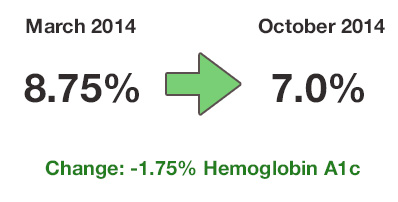
Result #6: Significantly Increased Activity Levels
In March of 2014, Cynthia was unable to exercise altogether. She recalls that "normal" blood sugars between 80-90 mg/dL gave her a headache and made her feel nauseous, sweaty and low energy. Because of this, she refrained from exercise altogether out of a fear that she could go severely hypoglycemic.
In addition, being overweight for a significant part of the last decade placed a serious strain on her body, resulting in a torn meniscus in her knee that gave her pain when exercising.
Within a few weeks of the Mangoman Nurition and Fitness Program, Cynthia began riding her bicycle daily. She currently exercises 20 miles per day every morning, and over 140 miles per week!
She now uses exercise as a tool to control insulin resistance, and has discovered the incredibly powerful effect that exercise has on reducing her blood sugar levels.
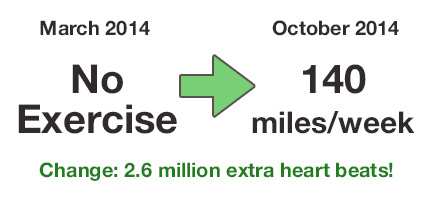
Cynthia's Tips and Tricks
I asked Cynthia to share a few tips and tricks that made her transition to an insulin-free lifestyle easy to manage. Having created a new lifestyle from scratch, Cynthia was ripe with suggestions that helped her maintain nutrition and exercise consistency. Her suggestions are here:
- Prepare food in advance, and put it into baggies. Weigh EVERYTHING you put in your mouth
- Eliminate all grain intake, eat beans instead, to minimize the symptoms of neuropathy
- Eat every 3 hours in order to keep your blood sugar levels constant
- Take your vitamins, especially minerals, each day
- Drink a lot of water every day
- Use an app to record the food you eat each day to make sure your ratios of fat, protein and carbs are correct, as well as other nutritional values. Graph your blood sugars to see overall trends
- Keep a daily journal about how you feel
- Remember this mnemonic: "Beans, Greens and Proteins. Then Fats and Fruits."
- Test your blood sugar 8 to 10 times every day. Find your peak blood sugar values, because those do significant tissue damage.
- Pay attention to how your body is really responding to the foods that you eat
- I take my bike with me on my car rack.....every where
- Read everything you can get your hands on, and believe only that which you can validate with your personal experience. Stick with this program - it works!
Take Home Message
So there you have it, yet another success story from a dedicated individual with a sincere determination to succeed. I have thoroughly enjoyed working with Cynthia, and have been inspired by her progress, her resolve and her focus on living life free from the constraints that diabetes initially placed on her life. And in the process, Cynthia reminded me of one of the most important principles in life:
There is no limit to how good you can feel. Unlock your mind and unleash your body's potential for positive change.
Want to Learn More?
The best way to learn how to Conquer Diabetes like Cynthia did is to join myself, Robby Barbaro and Dr. Douglas Graham for CONQUERING DIABETES WEEK on September 11th - 18th in Sedro-Wolley, Washington State!
Dr. Cyrus Khambatta, PhD Nutritional Biochemistry has been living with type 1 diabetes for 12 years.
Cyrus has used himself as a human guinea pig to conduct hundreds of experiments on ways to control and eliminate insulin resistance. In combination with rigorous science, Dr. Khambatta has been able to transform his health and the health of his clients with diabetes by measuring, tracking and reversing insulin resistance.
Dr. Khambatta runs personal and group coaching programs for people living with diabetes, and teaches the fundamentals of measuring, tracking and reversing insulin resistance using a plant-based diet. His clients regularly increase their insulin sensitivity by between 250-1000%.
Experience the program, meet Dr. Khambatta, Dr. Graham, Robby Barbaro and others with diabetes at FoodnSport's Conquering Diabetes Retreat this September.
See more about Dr. Khambatta at his MangoMan Nutrition and Fitness website.
Additional ResourcesBlog:
- Conquer Diabetes Like Robby Barbaro (with Dr. Graham): Plus Robby Discusses His Retreat Experiences
- Fruit Sugar Causes Cancer, Diabetes, Candida, and Hypoglycemia?!? by Dr. Graham
- Conquering Diabetes with Fruit-Based Diet - Interview: Robby Barbaro
- Overcome Hyperglycemia Just Like Kristina Did
- Which Banana Island Would You Like To Visit? by Dr. Graham
- Fruit, the Most Misunderstood Food by Dr. Graham
- Fruit, Fruit, More Fruit ... and Fruitarianism by Dr. Graham
- The Low-Fat Diet in a Nutshell by Dr. Graham
- The Best I Have To Offer by Dr. Graham
- How Diabetes Develops In a Person Over Time: And how it can be reversed in an even shorter time. by Dr. Graham
Retreats:
Conquering Diabetes
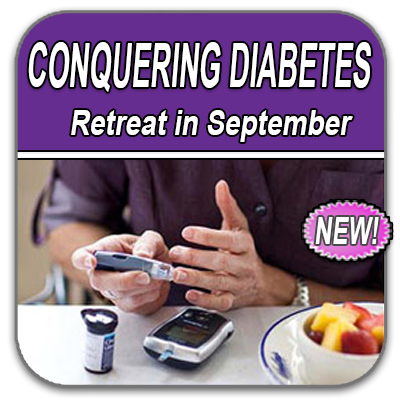
Keep It Simple & Heal
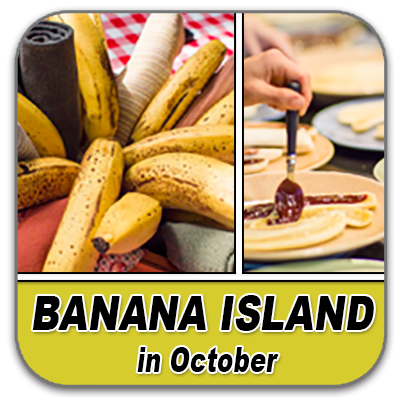
Self-Study Materials:
The Sweet Solution
to Diabetes

The 80/10/10 Family
Membership

80/10/10 Bootcamp
How To Live 80/10/10
